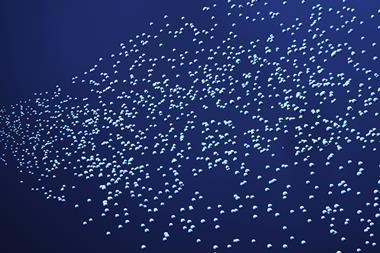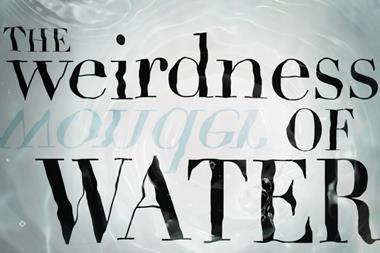Experiments in ultracold water droplets have revealed new insights into how covalent hydrogen chloride turns into hydrochloric acid as water molecules are added one by one. The work could potentially provide insight into other proton transfer reactions such as base chemistry or even DNA mutation.

Hydrochloric acid is perhaps the best-known acid in chemistry. Like most acids, it is a covalent compound when anhydrous. ‘When water molecules interact with the HCl molecule, they form hydrogen bonds,’ explains spectroscopist Fan Xie at DESY in Hamburg. ‘During this process the hydrogen atom leaves the chlorine atom, forming ions, then the hydrogen ion, or proton, combines with water to form a hydronium ion… We know that without water it does not dissociate, with one or two waters it just forms hydrogen bonds, but in solution – with billions and billions of water molecules, it dissociates. So, the question is how many water molecules does it take to dissociate one hydrochloric acid?’
Xie and colleagues in Melanie Schnell’s group fired a supersonic jet of water vapour and hydrogen chloride into a vacuum, producing ultracold clusters of hydrogen chloride surrounded by between one and seven water molecules. They analysed the rotational transitions of the molecules using microwave spectroscopy. Key to this analysis, explains Xie, is that the nuclei of chlorine atoms have an electric quadrupole owing to the arrangement of the protons and neutrons. This quadrupole couples to any electric field gradient in the chloride ion, altering the rotational energy levels.
In a perfect chloride ion, there is no asymmetry in the charge distribution around the chlorine nucleus and no electric field gradient. However, in the covalent molecule, the charge distribution around the chlorine is highly asymmetric, so the nuclear quadrupole strongly influences the rotational transitions. The researchers computationally predicted the energies of various rotational transitions in molecules with various possible configurations. They then compared these with their actual spectra to find out which of these molecules were present.
When there were four or fewer water molecules in the cluster, the hydrogen chloride remained covalently bonded. With five water molecules, however, they saw evidence of contact ion pair structures, in which the electron has moved from the hydrogen to the chlorine but the two have not separated. The researchers were unable to make useful measurements with six water molecules for technical reasons, but even when the number of water molecules was increased to seven, they saw no evidence of this fully separated structure. ‘When a proton runs away and joins a reaction, that’s an acid,’ says Xie.

The researchers suspect that these fully solvated structures may not have been seen because the low temperatures used to maintain the rotational states for analysis may have provided insufficient activation energy for the transition. The contact ion pairs are theoretically predicted reaction intermediates and provide fundamental insights into the mechanism, says Xie. He hopes it may prove possible to study other reactions such as proton acceptance by bases and some more complex systems. ‘In DNA, for example, when a proton tunnels between base pairs, that’s where a mutation happens,’ Xie explains.
Spectroscopist Brooks Pate of the University of Virginia in the US is impressed. ‘Many, many people have tried to get clear evidence of this process and this group has finally done it,’ he says. ‘It’s a culmination of many decades of experimental work.’ He believes the most important recent advance lies in theory and computation. ‘I’m sure I’d measured this in 2012, but I couldn’t analyse the data,’ he says. ‘It’s really shocking how good quantum chemistry and computational chemistry have gotten, and experiments like this test whether these models are really doing what they’re supposed to.’
References
Fan Xie, DS Tikhonov and M Schnell, Science, 2024, DOI: 10.1126/science.ado7049

















No comments yet